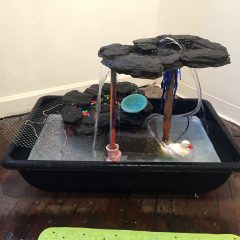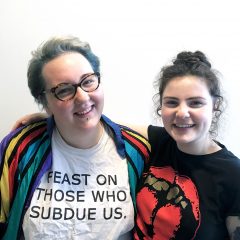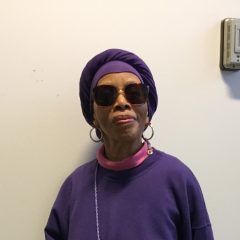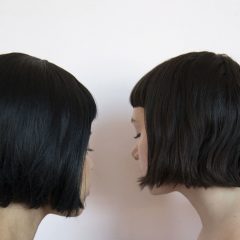You may recognize Katie Rauth from her hyper queen (cis-woman) drag persona, Lezzie McGuire. Or perhaps you’ve attended an installment or two of Wavelengths— the performance series that she organizes and curates featuring experimental drag performers. Now this self-described queer fat femme elitist and art babe is a 2018 recipient of the Leeway Foundation’s Art and Change Grant. I spoke with the West Philadelphia-based Rauth about her Leeway project, which began this summer with public forums on fat phobia and fat liberation and will include a forthcoming collaboratively-written video and performance project.
Sarah Kim: What drew you to performing as a hyperqueen?
Katie Rauth: So the first work I made about drag was a huge critique because I started out with this Second Wave feminist view that drag takes stereotypes of femininity and misrepresents what it is to be a woman. Once I got into performing drag, my world view of what drag is inclusive of expanded. I was leaning into these tropes of femininity and blowing them up — using drag as a vehicle to explore and press up against high-femme invisibility within the queer community. Recently though, all I have been thinking about is radical fat politics and how to incorporate that into my art practice.

SK: In fact, you received a 2018 Leeway Foundation Art and Change Grant for a project on radical fat politics. What inspired that project?
KR: There’s really a gap in activist and political discourse around fatphobia and how it truly affects everyone. Even the the most progressive people are still very fatphobic and don’t see an issue with it.
I want to find an entry point to this conversation for people who have never really talked about radical fat politics or never heard that framework before, and have it still be relatable content for fat queers — specifically fat femme queers. Most of the time it’s thought of as body positivity, which really is a watered-down version of fat positivity. It’s the accessible version that de-centers fat people and fat oppression and centers thin and straight-sized people finding a way to love themselves. You know, there’s a lot of thin and straight-sized people who don’t love their bodies and themselves because of fatphobia. Attacking that root issue is how we all can gain.
SK: Why did you choose video as the primary medium for your project?
KR: I originally came to this project because Legally Blonde is one of my favorite movies in the entire world. There’s that one scene of Elle Woods’s Harvard video essay, and it kind of stuck with me that I wanted to recreate, redefine and rework that (in my mind) iconic piece of cinema (laugh). With this project I’m using influences both from that movie and from But I’m a Cheerleader — another late 90s/early 2000s, femme-centric, camp classic.
I’m not necessarily recreating scenes from these films, which are really nostalgic for me; I’m mostly taking aesthetic influences and noticing the way they frame and set up jokes. There are some cinematic tropes that I’m really interested in, like the “getting-ready” montage. These women hit their alarm clock in the morning, and then you see them wake up and go to the bathroom and brush their teeth, then put on their make-up and pick out their outfit. This is something that you see in so many movies and it’s actually called “lipstick and load,” which comes from “lock and load” — a trope in action movies when people are strapping their guns into their holsters and pulling their boots on. It’s this femme version of it, which I think is really incredible—like gearing up for the day, putting on your warpaint, finding the way you want to present yourself to the world. I definitely want my own version of a “lipstick and load.”
SK: Can you talk about the role of humor in your work?
KR: Yeah. I’m working with the idea of camp, which is rooted in queer humor, but is often defined by gay men. Everybody says, “Oh camp, you’re doing stuff like John Waters.” If you’re looking at camp from a historical standpoint, then yes, but my goal is to define queer-centric, trans-centric and women-centric places within camp.
I recently read Mikaella Clements’s incredible article about dyke-camp, which finds a place for lesbian humor within camp. So I’m pairing camp with glamor, which is an institution traditionally defined by thin white women, to start a conversation. While I’m drawn to these modes of expression because I personally find joy in them, I think that people can also better understand conversations when they’re framed in an almost light-hearted or humorous way.
SK: Humor can ease people into difficult issues but it’s also something that fat people are often pigeon-holed into. Melissa McCarthy is a noteworthy example.
KR: First about the fat-funny trope. With Melissa McCarthy, the punchlines are either built around her fatness or they’re funnier because they’re coming from a fat woman. But the physicality of fatness…the oppression that fat people face is not funny. The direction that I’m going in right now kind of takes the piss out of thin people and straight-sized people.
Back in June after I got the grant, I did this outreach group. Because I only have my own experiences, I wanted to create space for other fat queers to tell their stories, and for me to hear what they feel comfortable making jokes about and what they feel is off limits. It ended up being sort of a brainstorming session for my writing that intermingled their advice for me and their own experiences. We hit on this issue of exercising and fitness culture; yoga culture is just in general very weird to me, and there’s a lot of jokes to pull out of that. Most of my humor comes from conversations I have with other fat people, because if you don’t laugh you’re going to cry. But that’s what fat positivity is: it’s finding joy in fatness.
SK: How do you reconcile drawing so many of your narratives from early 2000s pop culture (which is hyper-capitalist and hyper-commercial) with a radical fat activism that opposes the “body positivity” movement’s capitalist undertones?
KR: Pop culture is something I’ve always really identified with. There’s this idea that pop culture is vapid or is a guilty pleasure. I’d like to push back on that because pop culture is so important in how it shapes how we view ourselves and how we view the world. You can really enjoy something that’s kind of fucked up, as long as you’re having the conversation about why it’s fucked up. People have to draw lines for themselves.
SK: Since so many cultural attitudes towards fat people are restrictive —”You can’t eat this or wear that because you’re too fat” — can an excess of materialism actually be subversive?
KR: It comes back to this idea of gluttony. I’m drawing parallels between “don’t eat too much” and “don’t consume too much,” and pushing back against both. Right now we’re seeing a lot of activism against oppression used to sell us things — specifically Dove’s campaigns, of “this is what a real body looks like.” It’s just garbage to use that language to talk about bodies because we all have real bodies. Why not use these modes that the media uses to sell us stuff and sell some good shit, sell fat liberation?
SK: Even while pop culture performs body positivity, the art world remains extremely fatphobic. How do you feel you, your work, and fatness are positioned within the art world?
KR: In any public position that you hold as a fat person, you’re being scrutinized and tokenized. As fat lib comes more into the mainstream, people try to get brownie points for including fat artists or spotlighting them. Because it’s my community, I know a few fat artists who are doing some incredible things, but none of them have gained notoriety in a larger sense. Shug McDaniels is a queer, trans, fat photographer that travels all over and does really incredible intimate photography of fat people. Shona McAndrew is doing paintings and large scale representational sculptures. Wit Lopez in Philly is a fat black disabled trans performance artist. Their work focuses on the intersection of all their identities and often, they center other fat people of color in their work, which is notable because how often do we see these things? Jamal Lewis, who most recently was on the new FX series Pose, is a documentarian and academic and is talking a lot about blackness, fatness and queerness, and is also a fat trans person of color. Lopez and Lewis are making work about their existence, but their existence is more than just their fatness. They’re making work about the intersection of their identities. So there are people out there, but their work is mostly celebrated in niche communities.
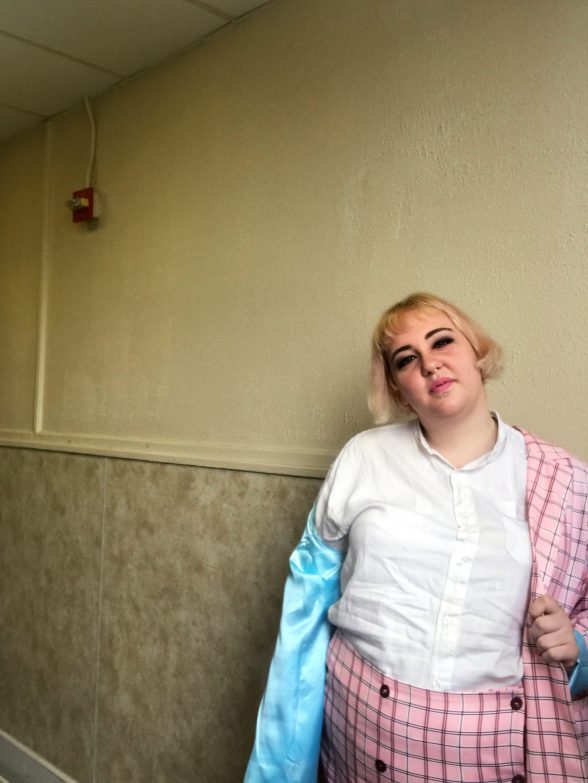
SK: As a white, cis woman drawing from white-centric films, how do you achieve your goal of making work that is as inclusive as possible?
KR: I can’t pretend to know other identities and experiences. This is part of the reason I had roundtable discussions with other fat people. During those, I was definitely confronting my own racism in centering my perspective as a white person. We were talking about fat sex and fat sexuality, which is something that you never see portrayed. I was talking about how I felt empowered by experiencing fat nudity because my body has always been desexualized because of my fatness. Then a woman of color in the room spoke about finding power in her modesty, because her fatness was looked at as sexual from a young age and produced trauma for her. Culturally, whiteness and thinness as beauty standards are so tied together, but that’s not so much the case in specifically black and brown communities. I thought I was being counter-cultural by being fat and scantily clad, but she feels empowered by covering up her body, and that’s valid.
I can’t write these experiences — I need to find people who have lived these experiences to write them. That means shifting things around to pay people to help me. It’s emotional work so I need to make sure that they are compensated for it.
SK: Who is your Change Partner for the Leeway project, and how are they connected to the broader community?
KR: Melissa Krechmer is my Change Partner, and she runs what we call “fat group.” It’s a specifically queer, fat-positive process group at the Walnut Psychotherapy Center I’ve been going to since April of 2017. She is a licensed clinical social worker who does therapy specializing in body image; as a queer fat woman, this is what she lives as well. I have never been part of a space like this before. Every Tuesday it’s a room full of fat queer people, and I can’t tell you how powerful that experience is to have a truly safe space to come every week and talk about issues throughout our week.
SK: What do you think a fat inclusive world would look like?
KR: Oh my god — chairs without arms! Dining out is a horrible, dehumanizing experience for so many fat people. Even making sure your chairs are stable enough — I’ve had chairs break on me on at least two or three occasions. At a certain point, I just started laughing it off, because what else can you do? But it’s a mortifying experience — the crack of a chair is so traumatizing to a lot of fat people.
For events: saying how many stairs, or what the accessibility is. There’s a huge intersection between fatphobia and ableism; I actually can’t go on a long hike or ride my bike all the way to Port Richmond. We all have different abilities, and the energy it might take you to carry your body ten blocks is half of what it takes my body. It’s hard because we’re so used to finding ways to navigate the world we live in and trying to find survival tactics.
Often I feel excluded intentionally because, as a fat person, my patronage is not wanted. My existence is seen as an epidemic.
SK: How would you define ‘fatness,’ as opposed to its common synonyms like ‘overweight,’ or ‘large?’
KR: It’s hard to give a solid definition for fatness, but there are categories of fatness that directly correlate to privilege. Small fats have the most privilege; most people would say, “oh, you’re not fat, you’re beautiful.” They typically have an easier time finding fashionable and affordable clothing in their size and physically navigating the world while medium fats, which is how I self identify, face more difficulty with both. Then Superfats, who have the least amount of privilege, are the most often targeted and denigrated for health issues.
I’m not upset by the term ‘large,’ because I am large and I’m fine with it. ‘Overweight’ signifies that there’s a normal weight, and fat lib is trying to break that idea. ‘Obese,’ medicalizes and dehumanizes; Roxane Gay writes about the term ‘morbidly obese’ in her book Hunger. ‘Curvy’ or ‘fluffy’ are ways for people to talk about their fatness that is not embarrassing because so many people still think of ‘fat’ as a bad word. Radical fatness reclaims the term ‘fat’ as a signifier rather than a slur. It’s not immoral. Radical fatness takes the morality of bodies out of the question. A thin body is not good, a fat body is not bad. Bodies are bodies. So many of these terms we use for fatness either have negative or positive connotations.The funniest one is ‘queen-sized.’ It’s a synonym for ‘plus-sized’ when they don’t want to say ‘plus-sized’ because of that idea of excess. I’ll take it though … I’m a queen.


